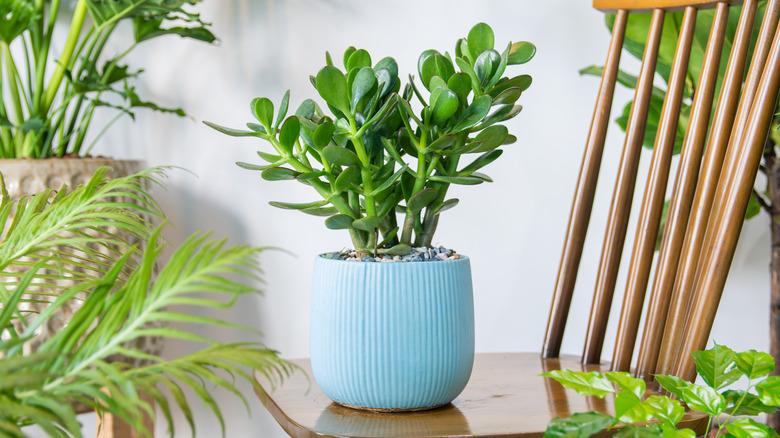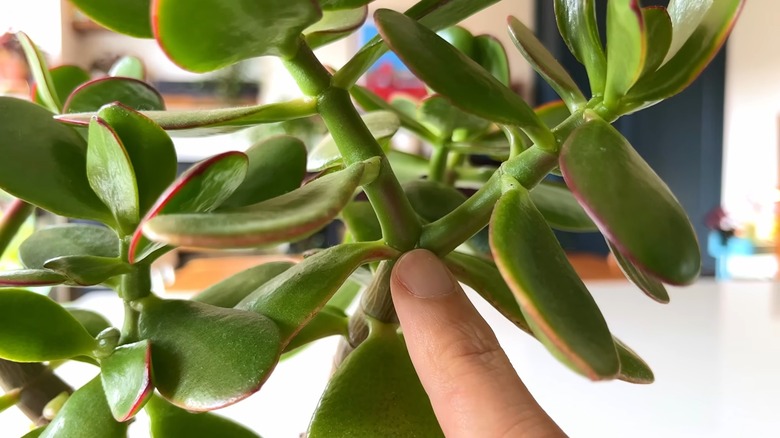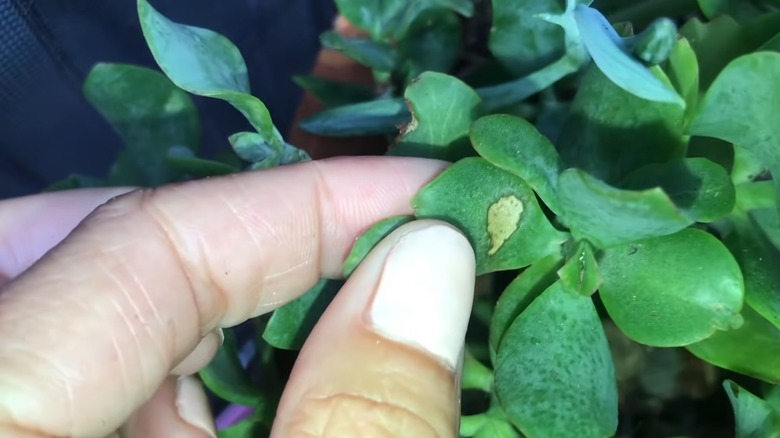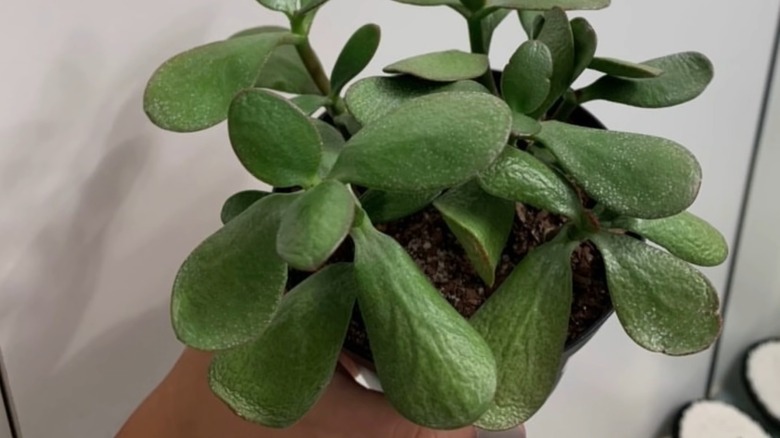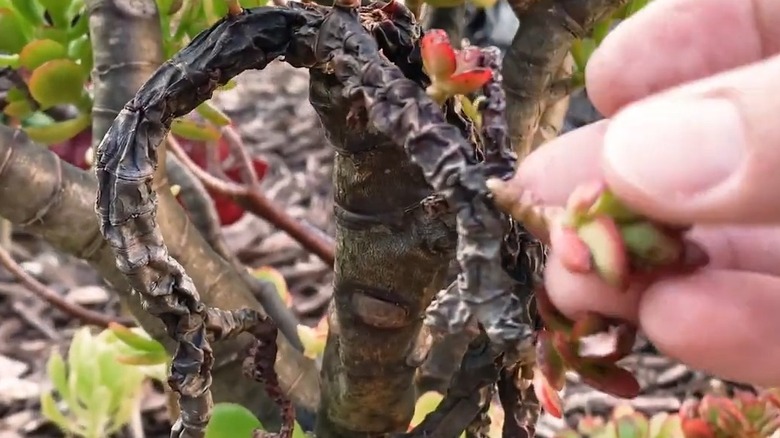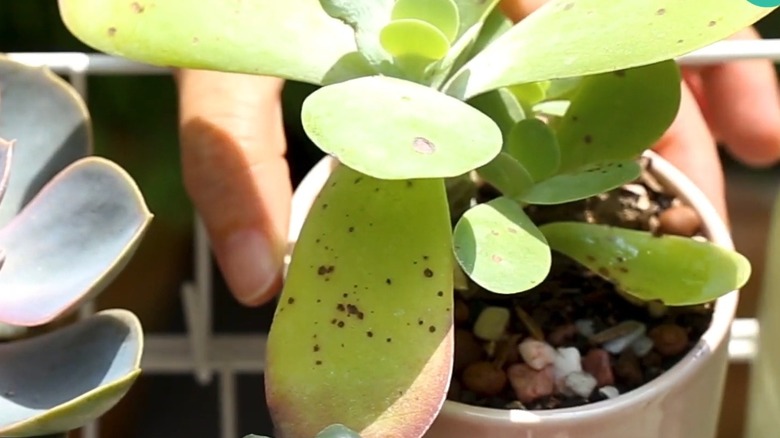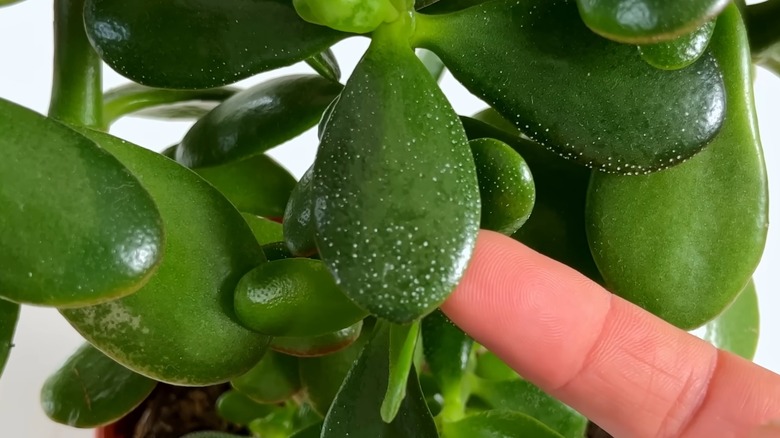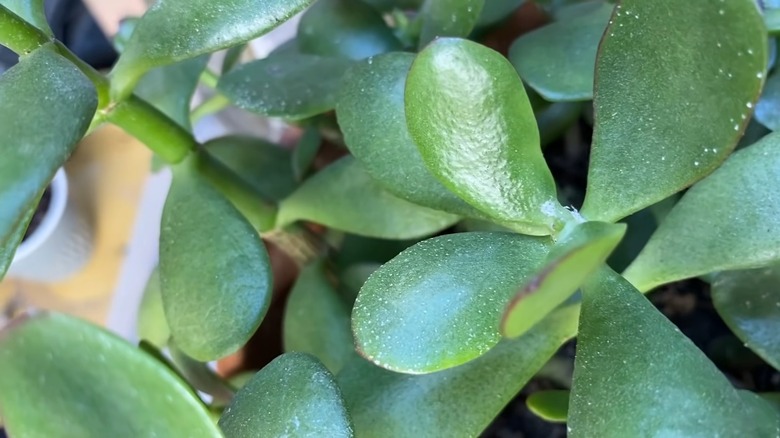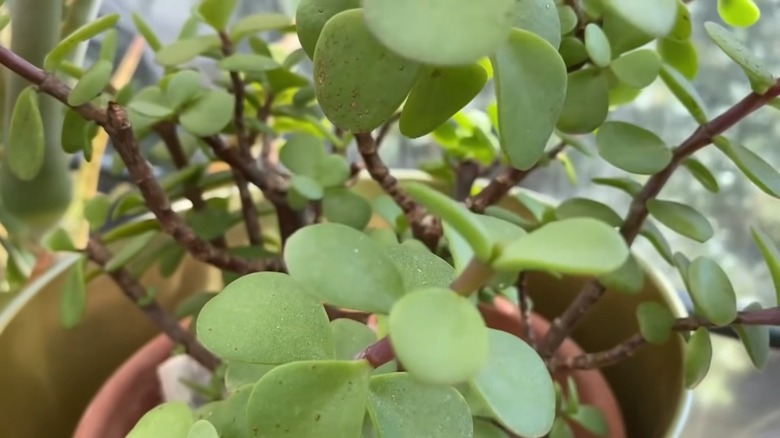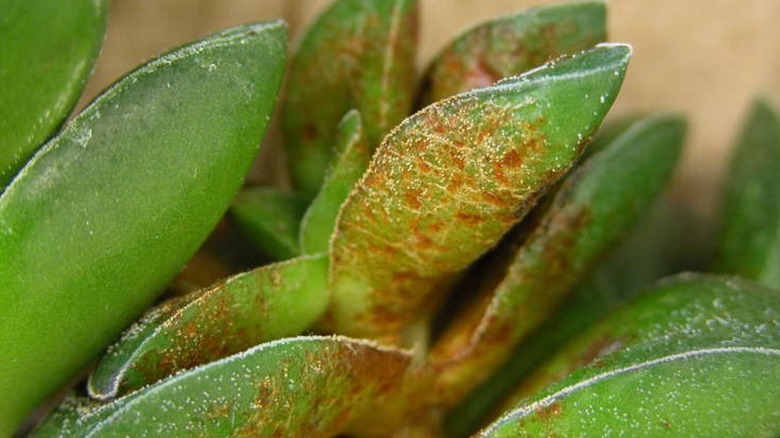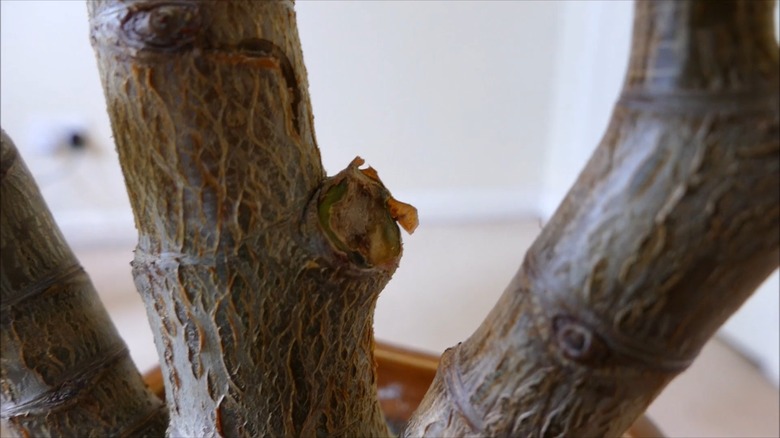How To Spot And Treat These Common Problems With Indoor Jade Plants
We may receive a commission on purchases made from links.
Last you checked, jade plants (Crassula ovata) were touted as one of the best succulents to grow indoors. You could leave them in the nursery pot for years, and they would endure without demanding a bigger container. Despite your home's dry conditions, they would persist long enough to complain about your neglectful care to your descendants — these beauties are surely long-lived! To top it all, they remain unproblematic, or as some put it, "hard to kill"— even by novice standards. Yet, jade plants are not exempt from problems like yellowing leaves, ugly scabs, and leaf drop — aka a plant that appears done with its existence. Worse, making any diagnosis feels impossible. For example, both underwatering and overwatering lead to leaf drop. So, which one is it?!
To demystify the process, we've discussed the common problems that could plague your jade plants, their symptoms, and the treatment. But before diving any deeper, take stock of your care. Are you watering your plants adequately? Are they receiving necessary sunlight? Are they sheltered from hot and cold drafts? Were they summered outside with pest-ridden ornamentals? Armed with this information, peruse your plants for their symptoms. Make sure to account for all signs of distress, as relying on a single one might lead to an incorrect diagnosis — after all, they're common to a breadth of issues. Ready? Let's spot and treat all that's wrong with your jade plant.
If your plant is pale, leaning, and stretched out, it's not receiving enough light
Jade hails from South Africa, specifically from its desert area, where it's exposed to intense sunlight for the greater part of the day. And growing it as a houseplant won't change its disposition. That's why, when your jade doesn't receive enough light, it starts leaning toward the sun for better access. This stretches it out, causing it to grow spindly (as the plant can't develop thicker tissues without proper sunlight) in a process called "etiolation." Due to the stretching, the leaves appear far more spaced apart than the dense, compact form you're used to. When low-light conditions persist, the emerald green leaves pale, nearly yellowing in extreme cases, and lose their characteristic red tips. They may eventually drop down, albeit in a limited fashion.
So, how do you sort out the low-light condition? By moving your plant to a south-facing window. Since it'd receive at least four hours of sun, that's the best place for a jade plant in your home. But if it proves insufficient, get full-spectrum artificial lights, like LBW's Grow Light. Pop your pot under the light for 12 hours and the plant should recover. Alternatively, slowly acclimate the plant to the outdoors during the summer, but bring it back inside before frost. For extremely leggy plants, consider pruning the leaning portion to allay the extra weight and repot. Drop the cutting in well-draining soil or water for more plants.
If your plant turns russet and gets burnt spots, it's receiving too much direct sun
Like underexposure, overexposure to sunlight doesn't bode well for your houseplant. As mentioned, jade plants perform the best with about four hours of direct sunlight — anything above that is a buzzkill. Even when sited well, they may suffer sunburn due to intense heat waves, especially if they were underwatered. Conversely, you might've irrigated them from the top, with the water droplets magnifying the sun's heat onto the leaves. Or, maybe you didn't acclimate them well when moving them outside for the summer. Notwithstanding the reason, the symptoms are the same: Green foliage will fade into yellow or white hues, until it burns to a russet brown color. These sun-scorched portions will usually be concentrated around the leafy margins, along the sun-exposed side. The leaves will ultimately grow crispy and brittle, and drop off.
Unfortunately, there isn't anything you can do about the sunburnt leaves. However, if more than ½ of your plant is sunburnt, snip off the dead leaves to redirect energy into new growth. Going forward, move your jade plant to a shaded spot initially (maybe on your deck or the patio) while acclimating it. If there isn't one, cover it with a shade cloth such as QLOFEI's 70% Sunblock Shade Netting. Gradually, increase the sun exposure over the next few weeks, but track the leaves for distress signals. During heat waves, consider moving your indoor plant to a more shaded site, especially during the afternoons when the heat is more intense.
If the jade leaves shrivel, grow stunted, and develop brown tips, your plant is under-watered
This one might surprise some, because jade plants became popular for being houseplants that you barely need to water — but barely doesn't mean none. Plus, it dislikes inconsistency. When under-watered, jade plants undergo drought stress, with their leaves growing shriveled or puckered, instead of maintaining their firm, fleshy form. Over time, the leaves will shrink, appearing dwarf and stunted. Their tips may turn brown, too, eventually spotting the entire leafy surface. Sometimes, you may also find them sprouting aerial roots (roots that grow from the stem) in a valiant attempt to absorb the air's moisture. Left unchecked, the plant will defoliate and experience an untimely death.
To further confirm whether under-watering is at fault, check the soil. Does it feel dry to the touch or does the pot feel light when lifted? If so, rejig your watering habit. For starters, begin watering your indoor plant every two weeks and maintain that schedule. Ensure the soil is drenched, but not soggy. If unsure, consider placing your pot in a water-filled, wide-rimmed saucer for about 15 minutes. Water more during the active growth season (spring through summer). To judge the requirement, poke your finger into the soil about 1 inch deep. If it seems dry, the roots need water. Hold off longer during winter, as the plants are semi-dormant. Also, avoid using cold water, as it may shock the plant and force it to drop leaves.
If your plant has yellow leaves, moldy stems, and is defoliating, it is being over-watered or standing in waterlogged soil
One significant reason for your jade plant's failure is over-watering. This can invite further problems like root rot. Key screening symptoms include yellowing, mushy leaves, and premature defoliation (of both old and new leaves). Stems, too, will be in a gooey state and will rot soon. In an escalated scenario, the plant may be colonized by mold or fungal spores. This will cause the leaves to wilt — despite the moist soil. If all these symptoms show together, remove your jade plant from its pot and examine the roots. If they emit a foul odor, appear brown and mushy, or are easily broken, they're experiencing root rot.
Sadly, over-watered plants can rarely recover and are usually discarded. If you still find healthy roots, try pruning the rotten bits after rinsing and potting down the jade plant. Another option is to salvage a healthy stem, allow it to harden over for a week and then repot it in sterile soil. That being said, sometimes you might find the same symptoms, despite careful watering. This could allude to poor drainage. If you haven't repotted jade in two years, it may have developed girdling roots that are blocking the drainage holes — in which case you must switch the planter. Otherwise, substitute the soil for a cactus mix, preferably in a terracotta container.
If your plant has brown corky blisters on the leafy undersides during late winter, it has edema
As mentioned previously, jade plants should be watered consistently. If not, they can develop edema, also spelled as "oedema." Simply put, when your succulents aren't watered for an extended duration, they end up absorbing excess water the next time they're given a deep soak. But because they cannot transpire or utilize the water fast enough, their oversaturated cell walls burst. This shows up as a collection of white pimple-like growth on the leaves' undersides, which eventually scab into brown or rust lesions. You can tell this damage apart from sunburn because the welts are raised and tough in texture. Sometimes, these corky welts can also be found on the jade's woody stems.
The reason edema is more common during late winter has to do with the humidity and soil moisture mis-match. Basically, if you've watered (or worse, over-watered) your plant and the weather is particularly humid, the roots will easily absorb the water as they're warm, but the leaves will lag in removing the water. Luckily, edema is more of a cosmetic issue and is unlikely to kill your plant. However, you must cut back on erratic watering so that the new leaves are healthy. When the tell-tale signs become apparent, stop watering your jade plant, discard any standing water, and allow the soil to dry completely. If required, run a dehumidifier in the house to bring the humidity levels to between 25% and 35%. The PSOS Dehumidifier will cover 1000 square feet and has a 120 ounce tank, making it a convenient option.
If the leaves are riddled with tiny white dots along their margins, your plant is discharging mineral deposits
When you drench your houseplant's soil in hard or alkaline water, it may lead to a buildup of mineral deposits. As jade leaves store some water, too, they will try to expel the salt residue during transpiration. These salt deposits will show up as white dots around the leaf's margins. If you try to rub them off, you'll succeed, and that's pretty much how you deal with them.
Wipe down the leaves with a moist cloth to remove mineral deposits. Going forward, give them filtered or distilled water whenever they get thirsty. To prevent the salt from accumulating in the soil, place your jade plant in the sink and run the tap over the soil to "flush out" the salts. Repeat the activity four times for complete riddance. If not, they may burn the roots, impairing plant growth. Make sure to discard any water that collects later in the saucer. However, if you're feeling unsure about the drainage, it's best to replace the soil with a succulent mix.
If your plant has mushy stems and is flopping over, it has suffered cold damage
Although you should place your jade plant by a south-facing window, there's a caveat: Don't let the leaves touch the windowpane. The reason? When it gets too cold during nightfall, your plant will take damage. Next thing you know, your plant will be discolored and flaccid, and may eventually start flopping over due to overexposure. It might also drop leaves or develop black tips. Be especially careful if your area temperatures drop below 50 degrees Fahrenheit, although some sources state that jade plants can tolerate dips to 30 degrees Fahrenheit if their soil is dry. Other instances where your indoor plant may take cold damage include exposure to chilly currents — like when it's placed in front of the front door. Naturally, if you've made the mistake of leaving your jade plant outside during frost, it will face a similar fate.
That being said, how can you deal with a cold or frost-damaged jade plant? First, you'll have to remove all the mushy and rotten bits, or they'll spread throughout the plant. Prune the damaged stems until you see healthy growth (uniform green color), but above the growth ring. Place the plant in bright light, but ensure it's a little away from the window throughout winter. However, it might not always bounce back if the damage is immense.
If your plant has white, cottony patches on its leafy undersides or between the joints, it's infected by mealybugs
Found white cottony fuzz on the foliage — and it moves? Well, your jade plant has been inflicted by its worst adversary: mealybugs. These tiny, white-bodied insects suck plants dry and can generally be found on the leaf's bottom and the joints between the stems and the leaves. Though, rarely, they may also be present in the plant soil or the pot's exterior. Over time, they'll cause the leaves to bleach. As they secrete a waxy substance (honeydew) that sooty mold colonizes, sometimes you may find black smudges on your foliage. In the worst cases, your jade plant will defoliate, grow stunted, and die.
So, how to get rid of mealybugs before they destroy your jade plants? First, quarantine your plant for a month, so the bugs don't infect other plants. Next, gauge the scale of infestation. Indoors, mealybugs have no beneficial insects to keep them in check. Plus, their female counterparts breed in enormous hordes (over 600 eggs!). Given these dynamics, disposing of the plants is the best option for a massive infestation. However, if you only spot a light presence, soak a cotton ball in rubbing alcohol and apply it directly to the bugs (they'll look brown). Repeat the process the following week until you eliminate all new hatchlings. Remember, the plant may never become mealybug-free and you may have to propagate new cuttings instead.
If the leaves are covered in sticky dew and brown bumps, your plant has scales
If there are times when your jade plant appears exceptionally glossy, chances are scales are to blame. While there are several scale varieties, you'll mostly find soft scales on your jade plant. Same as mealybugs, they suck the plant sap and secrete a gooey liquid, aka honeydew, in enormous quantities. Here, too, sooty mold may become a problem. Given the huge overlap between different generations, you might not always find the scales crawling, as only their younglings move around. Instead, you'll find most adults stuck in their place or a "house" where their bodies are enclosed by a brown covering. This appears as brown bumps on the jade foliage. If the infestation goes unabated, your leaves will turn yellow and drop, impairing plant vigor, or worse, causing early demise.
Dealing with scales is similar to how you would with mealybugs. Isolate the plant to control the pest's spread and assess the infestation level. If scales have taken over the plant, either toss it out or salvage a healthy cutting and replant. For smaller infestations, wipe down the bugs with an alcohol-soaked cotton swab or spray them with soapy water. If you aren't squeamish, you can squeeze the bugs, too. In case the infestation persists, use horticultural sprays to asphyxiate the pests. But make sure they're safe for succulents, since they don't usually respond well to chemicals. A safe choice is Bonide Captain Jack's Neem Oil.
If your plant has webbed, speckled, and yellowing leaves, spider mites are in action
When your jade plants start looking "dusty," they might have spider mites. These tiny insects leave brown or tan spots behind as evidence of their feeding, speckling the foliage. Given their namesake, they also envelop the leaves and joints with fine-threaded webs. In large amounts, they take over the whole plant, causing bronzing and eventually browning of the foliage until it detaches from the stems. If still unsure, place a white paper sheet under an infested leaf and tap it — it should dislodge tiny insects furiously dashing off.
To control spider mites, wash the leaves with water in a sink. Better yet, add a few drops of rubbing alcohol to water and wipe down the leaves using a cotton pad. Heavily-infested foliage should be cut back. If this fails, look for a pyrethrin-based miticide (such as Bonide Pyrethrin Garden Insect Spray Concentrate,) insecticidal soap, or horticulture oil and apply liberally on leafy undersides. Continue watering and fertilizing your jade plant as necessary.
If your plant has brown scabby lesions and white coating, it's been affected by powdery mildew
Surprisingly, powdery mildew can manifest a smidgen differently in succulents, including jade plants. Here, the fungal spores, like Sphaerotheca, relish the live tissue and pepper the foliage with several brown lesions that later scab over. This isn't to say the leaves won't show the white powdery texture characteristic of powdery mildew — they will — but it won't always be as readily apparent. That's because mildew-causing strains vary greatly across locations, with some being ostensibly obvious about their presence, while others are not. Regardless, they all lead to leaf distortion, dwarfing, premature drop, and death.
So, what's the best way to treat powdery mildew on jade plants? Clip off the infected foliage. Next, DIY a solution consisting of baking soda, water, and white vinegar in a 1:1:1 ratio. Mix the ingredients and spray them on the damaged leaves (but don't leave the foliage soaking wet). Alternatively, directly rub a cotton swab soaked in this solution on the mildew area. Concurrently, deal with unfavorable conditions. Powdery mildew emerges in cold, damp areas. So, take steps to dehumidify the room and ensure your jade plant receives adequate light. In case your houseplant is very dense and compact, prune a few stems for better airflow, but if it's unconducive, consider running a fan for a short while. Reduce watering until the plant recovers. Avoid overhead watering, but if you can't, carry it out early in the mornings, so the leaves can dry while the sun is out.
If the stems collapse on themselves and the foliage appears sunken and mushy, your plant has bacterial soft rot
Another problem that jade plants are susceptible to is bacterial soft rot. Caused by a bacteria called Erwinia, your plant will lose a limb or two for no apparent reason. In other words, you might find that the stems are collapsing on each other. On a deeper evaluation, however, you might find that their cell tissues are already sunken and mushed up, and the stems are soft in their centers. You might even notice some discoloration in the infected spot, along with a foul odor in the more extreme cases.
If this condition reminds you of an over-watered plant, that's because it is. Plus, bacterial soft rot usually occurs in wet weather. With that established, this bacterium can enter through pruning wounds, too. Other entry points include drafts, lawn equipment, insects, and contaminated water. Sadly, there's no way to save these plants and you must trash them (don't make the mistake of composting them).
